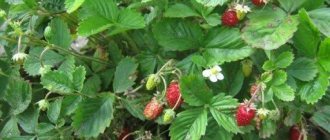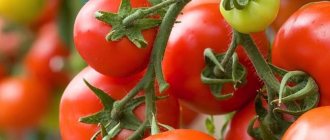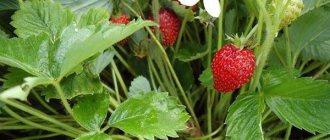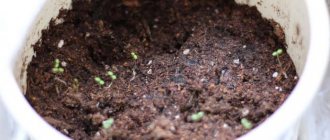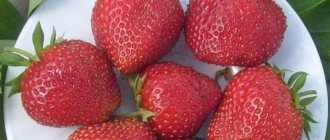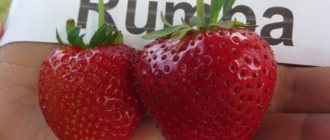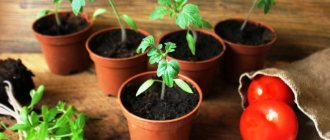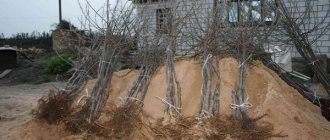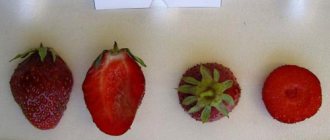Gardeners in our country, as well as any consumer of horticultural crops, are widely aware of strawberries that are juicy, red in color, with a pleasant aroma and exquisite taste. Such berries are eaten raw and processed. Compotes and all kinds of jams, juices and fresh juices made from fresh strawberries, or with the addition of red berries, attract attention not only with their aroma and appearance, but also with the availability of these berries. Every season, from early spring to late autumn, you can buy red strawberries in both small and giant sizes at vegetable markets and supermarkets. But hardly any of the consumers of these berries thought about the question of why the berries are red, and whether there are other, equally beautiful and attractive colors of these berries.
Characteristics and description of the variety
Strawberries called “Yellow Miracle” have an elongated conical shape. The average weight of one berry does not exceed 2.8-3 g . The pulp of the berry is juicy and sweet, with a very subtle and pleasant aroma. If there is insufficient sunlight, surface coloring may be almost completely absent. This variety has fairly high winter hardiness and is resistant to diseases and pests. Strawberry bushes are compact, no more than 23-25 cm high.
The variety has proven itself well as an ornamental berry crop and is quite often used in modern landscape design. “Yellow Wonder” has such a characteristic feature as the need to replace berry plantings every three years, which is due to a sharp decrease in yield after the third year of life of this strawberry variety. As a rule, gardeners use several methods to renew the berry fields in their garden plots.
Agricultural technology: what to pay attention to
Caring for yellow garden strawberries is simple, the basic techniques are standard, as when growing red varieties. The only problem is the absence or small number of tendrils in plants, which is why such species are propagated by seedlings purchased from nurseries or grown on their own from seeds.
On a note! Some summer residents rejuvenate their plantings by dividing 2-3-year-old strawberry bushes into several parts (divisions).
Growing seedlings
When sowing seeds, seedlings are first grown at home. The difficulty is that strawberry seeds are very small, germinate slowly and produce tiny string-like sprouts. To obtain high-quality seedlings, seeds are disinfected, mixed with sand, and sown without sprinkling soil on top.
Mixtures of peat, humus, and calcined river sand are suitable as nutrient soil. Sowing time is March.
Seeds are sown on the surface of moist soil, covered with glass and placed in a dark place for germination. Approximate time: 30-40 days. As soon as the sprouts appear, the boxes are moved to a lighted place.
Water over the soil, slightly moistening it with settled warm water. They dive only when the plantings are dense. If the seedlings grow rarely, then replanting is not required. It is recommended to highlight the seedlings, extending the daylight hours to 13-14 hours. As soon as stable warmth arrives, the seedlings are transferred to a permanent place. In the first days, the plants are slightly shaded from the bright sun. It is advisable to accustom the strawberries to new conditions in a couple of weeks, taking them out to the balcony or greenhouse for hardening.
Outdoor care
Seedlings are planted, maintaining a distance between holes of 25-30 cm, from one row to another - 30 cm. Yellow-fruited varieties are compact in size and do not require large areas.
Further care includes:
- weeding;
- loosening (after watering and rain);
- irrigation (depending on weather conditions);
- application of fertilizers (complex formulations are recommended). Fertilizing is applied 2-3 times per season.
It is advisable to mulch the plantings with peat, hay, and sawdust. The use of black agrofibre or film is effective when seedlings are planted in cuts in the material. In this case, the strawberries remain clean, and plant care is simplified (no need to loosen or weed the beds).
The harvest is harvested as it ripens, trying not to delay harvesting. This leads to the rapid formation of new inflorescences and increased yields of varieties.
There is nothing difficult in growing the still rare yellow garden strawberries. However, it can hardly be called exotic, since many gardeners appreciate the “advantages” of these varieties and willingly grow them next to ordinary red strawberries.
Growing from seeds
Strawberries called “Yellow Miracle” can only be grown by seedlings or by dividing the bush. The variety "Yellow Wonder" is most often grown from seeds. It is important to remember that such a procedure requires strict adherence to planting technology and agricultural technology:
- sowing strawberry seeds should begin at the end of February or in the first ten days of March, which will allow you to obtain strong, well-developed seedlings suitable for planting in a permanent place in open ground already in May;
- prepare clean planting containers 6-7 cm high with the obligatory presence of high-quality drainage holes;
- fill the planting containers with universal soil with the addition of a small amount of wood ash;
- about a day before sowing, water the soil in the planting containers with hot water with the addition of a small amount of potassium permanganate;
- strawberry seeds should be spread over the surface of the moistened soil using tweezers, maintaining a distance of 1-1.5 cm;
- cover the containers with the crops with film and place them in a warm room with optimal temperature conditions;
- You should check the soil daily for moisture levels and, if necessary, moisten it with warm water from a spray bottle;
- It is very important to periodically ventilate crops to prevent the formation of mold colonies on the soil surface.
If planting is carried out correctly and the specified temperature conditions are maintained, mass seedlings of strawberries appear approximately three weeks after sowing. Immediately after the appearance of strawberry seedlings, it is recommended to remove the film covering from the crops. Seedlings should be planted in separate planting containers after the third or fourth leaf appears on the seedlings.
Growing seedlings
Due to the fact that the Yellow Miracle variety does not form a mustache, propagation in most cases is carried out by sowing seeds for seedlings. For sowing, take a soil mixture of the following composition:
- peat from the store;
- garden soil with a neutral pH level.
The soil should be placed in a container or other container with drainage holes and disinfected with a weak solution of potassium permanganate. Before sowing the seeds, the soil should be thoroughly watered, pouring it through the holes in the container. Next, take small strawberry seeds, pour them onto a white saucer and, using a soaked toothpick, carefully place them on the surface of the soil base at intervals of 2 cm. Cover the container with cling film and place in a warm and bright place. The ambient temperature in the room where strawberries grow must be at least 20 degrees Celsius.
It is not recommended to water the seedlings and remove the film until shoots appear. If the soil is too dry, then you need to place the container with the seedlings in a tray with water.
The germination rate of the Yellow Miracle variety is good. When the first shoots hatch, the film is removed. When two or three good leaves are formed, the seedlings are planted in separate cups. Water each bush carefully, trying not to get water on the delicate leaves. When 5-6 leaves appear, the strawberries can be transplanted into open ground.
Care after landing
The description of the “Yellow Miracle” strawberry allows us to classify it as an unpretentious variety of small-fruited strawberry suitable for growing by beginners or inexperienced gardeners. When cultivating “Yellow Wonder”, it is recommended to pay attention to the implementation of care measures, primarily to fertilizing:
- for the first feeding in the spring, complex fertilizers with microelements or solutions based on the preparations “Effect” and “Vito” are used;
- the second feeding should be done at the stage of extension of flower stalks with a fermented solution of mullein or bird droppings with the addition of wood ash;
- The third and fourth fertilizing is carried out at the flowering stage and when preparing berry plantings for winter.
Standard care for strawberries also includes systematic irrigation, removal of weeds, loosening and, if necessary, planting of berry bushes.
Features of growing large-fruited varieties of garden strawberries (strawberries)
Gardeners have successfully planted strawberries with seeds for seedlings in the case of remontant, beardless varieties. For large-fruited varieties, growing from seeds is undesirable. Despite the similar technology of growing from seeds, the resulting plants do not inherit valuable maternal characteristics. In the first year of cultivation, the berries are similar to the described variety, but in subsequent seasons the fruits become tasteless, small and dry. On average, only 1 in 1000 seeds bears the characteristics of the variety. Therefore, large-fruited varieties of garden strawberries are propagated vegetatively. Young seedlings or mustaches are purchased from a trusted seller, and then propagation is carried out on your own plot by mustaches or dividing the bush.
New: Decorative strawberries
Hybrids of ampelous strawberries from Holland, grown for decorative purposes, are presented on the Russian market in the following varieties: 'Gasana', 'Tuscany', 'Laurent', 'Milan', 'Tristan'. These are potted and container plants. Technological techniques for planting ornamental strawberry seeds are similar to the methods for growing alpine varieties of strawberries. Ornamental strawberry seedlings quickly turn into compact bushes with early flowering. The main advantage of decorative varieties is crimson , pink or scarlet flowers . The berries have no distinct taste; instead of dense pulp, they have a watery structure. It is the decorative properties that are fully reproduced when growing plants from professional seeds.
Reviews and advice from gardeners
Strawberries called “Yellow Miracle” form a harvest of berries completely devoid of the classic red color. At the initial stage of ripening, the berries have an amber or yellow surface, and when fully ripe, the color changes to light, banana-yellow. Fully ripe berries, according to consumers, literally melt in your mouth. The taste of the berry is sweet, with a pronounced pineapple aftertaste. The advantage of the variety is its lack of tendency to shedding. It has been noted that the absence of a mustache significantly complicates independent reproduction.
Description of the strawberry variety
Strawberries "Yellow Miracle", as I already said, are distinguished by the light banana color of the berries. In addition, they are quite large, ellipsoidal in shape, 2.5 cm long and 1.5 cm in diameter, weighing about 3 g.
Sweet juicy berries have a pronounced pineapple flavor; they are best consumed immediately after picking, but the jam is in no way inferior to that made from ordinary garden strawberries. Even small children can eat berries; they do not cause allergies, as they do not contain red pigment.
Small, neat bushes reach a height of 20-25 cm and do not require special care, but every three years it is necessary to renew the clearing, as the yield decreases sharply. Strawberries practically do not reproduce on their own due to the lack of whiskers.
Main characteristics of the variety
The list of characteristics of Holiday garden strawberries is contained in the description, reviews from gardeners and photos of the plant. In appearance, the variety resembles ordinary strawberries, but the qualities were incorporated into it by breeders. Refers to non-remontant species.
Attention! If a gardener wants to plant a remontant variety, then you should read the description of the Holiday yellow strawberry variety.
Fruiting time, yield
The yield of the variety depends on compliance with agrotechnical measures. If Holiday is grown taking into account the recommendations, then 1-1.5 kg of ripe strawberries are collected from one adult bush. Strawberries show a decrease in yield every year. The berries become a little smaller, but the presentation does not change. Therefore, the Holiday variety must be renewed regularly to maintain fruit size. An increase in yield is observed with compacted cultivation technology of the variety.
The fruiting period is medium-late, the ripening of berries is very amicable.
Application area
According to reviews, Holiday strawberries are classified as fruits of universal use. The dessert taste and aroma of strawberries allows Holiday to be used for fresh consumption. Density and meatiness - for transportation or processing. Strawberries are used for making purees, jams, and compotes. Frozen berries retain their structure well.
Resistance to diseases and pests
The originators of the variety noted Holiday’s resistance to crop diseases. To protect plantings from the invasion of pests or diseases, it is enough to carry out preventive measures.
Advantages and disadvantages
Thanks to the description of Holiday strawberries and reviews, we can highlight the pros and cons of the variety.
Advantages:
- High yield from one bush.
- Harmonious ripening of berries.
- Dessert taste and pleasant aroma.
- Drought resistance and winter hardiness.
- Good immunity against diseases and parasites.
- Suitability for transportation.
- Versatility of use.
Among the disadvantages noted by gardeners are:
- Demanding on the schedule and quality of fertilizing.
- Reduced taste during periods of drought or moisture deficiency.
- Reduction in fruit size in subsequent harvest waves.
- Demanding on soil fertility, which affects the yield.
It cannot be said that such shortcomings are inherent only to Holiday strawberries. With the right agricultural background, they are significantly reduced, and the variety demonstrates its declared characteristics.
